
Soil Test Sieve can be used for soil grading, screening, analysis, testing, filtering various soils, widely used in laboratory analysis and sample monitoring.
Price: $20.00 - $200.00/set Chat Now
Diameter: 100/300/400mm
Soil sieve specifications: φ200*50, φ300*60, φ400*65
Soil sieve aperture: 0.074mm, 0.25mm, 0.5mm, 1mm, 2mm, 5mm, 10mm, 20mm, 40mm, 60mm
Screen frame layers: 1-8 layers
Layers: 1-8 layers
Can be used for powder, sand, cement, coarse sand, soil, stones, etc.
Product selling point
Screen: ①Wire woven mesh: 0.074mm-1.0mm; ②Metal perforated plate screen: round holes above 2.0mm
Screen frame: ①chrome-plated punching frame: high hardness and more wear-resistant; ②stainless steel material: anti-corrosion, heat insulation, easy to clean
Port:Any port in China (Mainland)or as you need.
| Quantity(sets) | 1-2 | >2 |
| Delivery time(days) | 5 | To be negotiated |
Soil Test Sieve, also known as standard Soil Test Sieve, is a sieve used for soil testing and filtration, mainly used to separate soil of different fineness, suitable for soil nitrogen content determination, soil potassium content determination, soil carbonate determination, etc. For soil screening in various experiments, the sieve frame and screen are made of 304 stainless steel, which is not easy to rust and easy to clean. Different fineness of soil can speed up the operation steps in the laboratory.
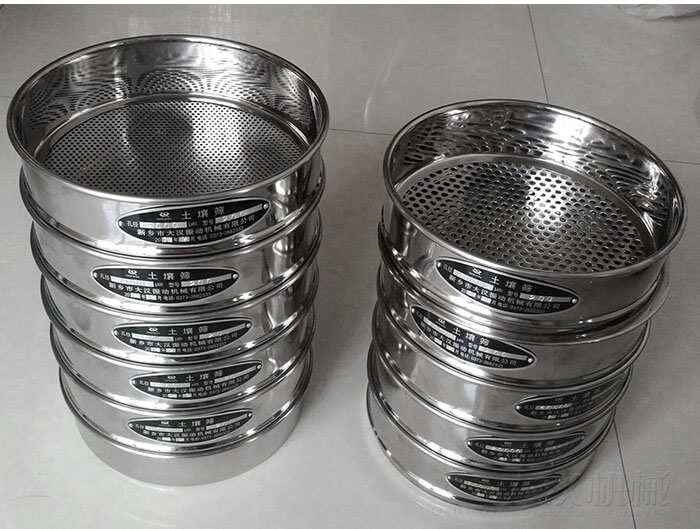
Soil test Sieve is a special equipment for separating and sieving the residual plants and soil. After the experiment, the soil can be submerged, and the residual plants can be left on the top. The soil detection results obtained in this way are much more accurate. Use a soil sieve to remove The residual plants in the soil are convenient for measuring various data contents in the soil in the following work, and the residual plants in the soil can be extracted separately, so that the proportion of the plant debris in the soil can be simply calculated, from From the perspective of organic fertilizers, the degree of emeraldness of the soil is judged.

Soil test Sieve saves a lot of time for people in the process of soil experiments, and makes the experimental results more accurate. Its application is of great significance to agricultural experiments.
1. Particle separation: Soil samples may contain particles of different sizes. Using a sieve can separate the particles in the soil sample according to size, which is convenient for subsequent particle analysis and research.
2. Particle size distribution analysis: By sieving soil samples, particles within different particle size ranges can be obtained, so as to understand the particle size distribution of soil samples and provide data support for soil texture analysis and soil property evaluation.
3. Removal of impurities: The sieve can help remove impurities in soil samples, such as stones, plant residues, etc., making the soil samples purer, which is conducive to the accuracy of subsequent experiments and analysis.
4. Convenient experimental operation: Sieving can make soil samples easier to operate and handle, making the experimental process smoother and more efficient.
5. Standardized analysis: In soil analysis and research, soil samples are usually sieved according to standard procedures to ensure the comparability and accuracy of the analysis results.
Soil Test Sieve is an important tool for soil analysis. Its main purpose is to separate soil particles of different sizes. Through screening, the particle size distribution information of the soil can be obtained, and then the physical, chemical and engineering properties of the soil can be analyzed more deeply.
Soil Test Sieve is suitable for analyzing soil with a particle size greater than 0.074mm, and can separate soils of different finenesses. It can be used for soil nitrogen content determination, soil potassium content determination, soil carbonate determination, soil sieving, sand, cement, coarse sand , soil, stones and other experiments.
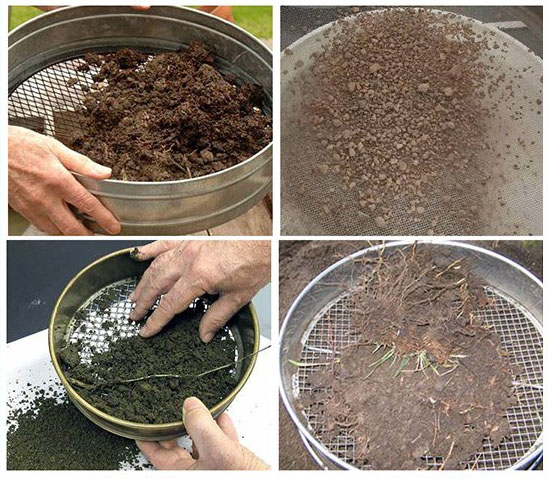
1.Agricultural field: Sieving soil samples to determine soil texture, providing a basis for selecting suitable crops. Analyzing the particle size of soil particles to understand soil porosity, thereby assessing soil aeration and water retention. Sieving soil samples to analyze the content of organic matter in the soil providing a reference for fertilization.
2.Environmental monitoring: Sieving soil samples to analyze the distribution of pollutants such as heavy metals, assessing the degree of soil. Analyzing the particle size distribution of soil particles to study the mechanisms of soil wind and water erosion.
3.Engineering construction: Sieving soil samples to determine liquid limit, plastic limit, and other indicators of the soil, providing a basis for soil classification and evaluation of engineering properties. Analyzing the particle size distribution of soil to determine the permeability coefficient of the soil, providing data for the design of impermeable engineering.
Soil Test Sieve specifications: φ200*50, φ300*60, φ400*65.
Soil Test Sieve aperture: 0.074mm, 0.25mm, 0.5mm, 1mm, 2mm, 5mm, 10mm, 20mm, 40mm, 60mm.
Note: 1mm can sieve dust powder in soil, 3mm can sieve 1-3mm soil particles, 6mm can sieve 6mm medium soil particles.
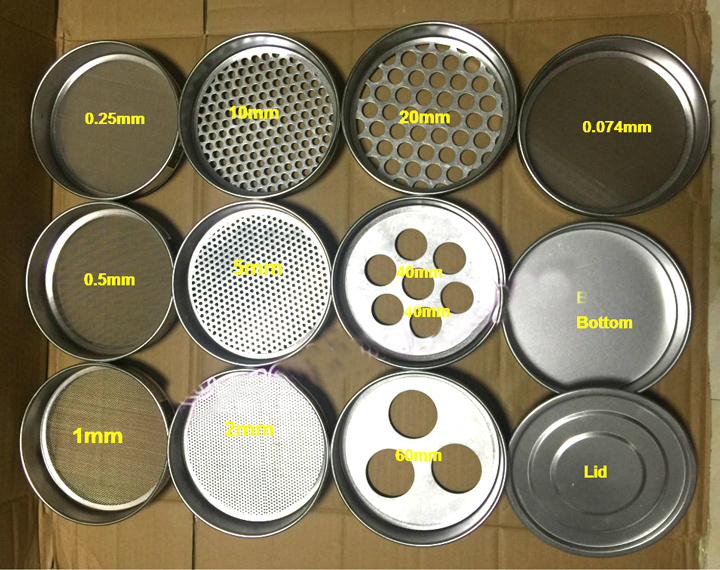
| Specification | Sieve hole(mm) | Specification | Sieve hole(mm) |
| Square hole copper mesh | 0.074 | Iron plate round hole | 5 |
| Square hole copper mesh | 0.25 | Iron plate round hole | 10 |
| Square hole copper mesh | 0.5 | Iron plate round hole | 20 |
| Square hole copper mesh | 1.0 | Iron plate round hole | 40 |
| Iron plate round hole | 2.0 | Iron plate round hole | 60 |
| Non-porous sieve | bottom cover |
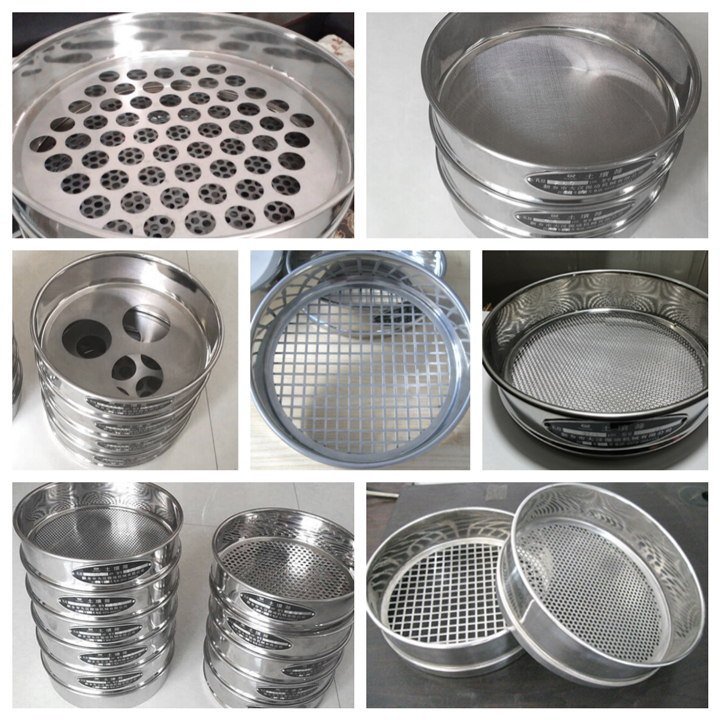
Soil Test Sieve is divided into conventional soil analysis sieve, gravel soil sieve, sand special sieve, cement soil sieve, asphalt soil sieve, coal sample analysis sieve, metallurgical ore inspection sieve, etc.
1. Standard square hole gravel sieve aperture: 9.5mm, 4.75mm, 2.36mm, 1.18mm, 0.6mm, 0.3mm, 0.15mm, 0.075mm, a set of bottom cover.
2. Standard square hole stone sieve aperture: 95mm, 75mm, 63mm, 53mm, 37.5mm, 31.5mm, 26.5mm, 19mm, 16mm, 9.5mm, 4.75mm, 2.36mm, a set of bottom cover.
3. Standard square hole pitch screen aperture: 95mm, 75mm, 63mm, 53mm, 37.5mm, 31.5mm, 26.5mm, 19mm, 16mm, %2B13.2mm9.5mm, 4.75mm, 2.36mm, a set of bottom cover.
4. Standard round hole Soil Test Sieve aperture: 60mm, 40mm, 20mm, 10mm, 5mm, 2mm, 1mm, 0.5mm, 0.25mm, 0.075mm bottom cover.
Put the Soil Test Sieve frame on the test sieve machine, turn on the power, and use the vibration motor as the vibration source. The vibration of the vibration motor will drive the vibration of the base of the sieve machine, and then conduct it to the soil sieve placed on the base through the base, so that the soil sieve smaller than the soil sieve The material particles in the mesh of the sieve surface are screened into the soil sieve of the lower layer, so that only materials with the same particle size are left in each layer of soil sieve. To achieve the separation of different particle sizes and to determine the particle size composition of this material. The purpose of making the materials in the soil sieve can be effectively screened, graded and filtered.
φ200mm (11pcs/set+bottom cover) 0.074, 0.25, 0.5, 1.0, 2.0, 5, 10, 20, 40, 60mm Standard screen frame material: stainless steel plate, brass plate, cold-rolled iron sheet (chrome-plated or zinc-plated) , plastic and other materials. It adopts one-time stamping and forming, the screen frame is flat, the finish is high, and the sets of screens are assembled and interchanged.
| mesh | Aperture(mm) | mesh数 | Aperture(mm) | mesh数 | Aperture(mm) |
| 2 mesh | 12.5 | 45 mesh | 0.4 | 220 mesh | 0.065 |
| 3 mesh | 8 | 50 mesh | 0.355 | 240 mesh | 0.063 |
| 4 mesh | 6 | 55 mesh | 0.315 | 250 mesh | 0.061 |
| 5 mesh | 6 | 60 mesh | 0.28 | 280 mesh | 0.055 |
| 6 mesh | 4 | 65 mesh | 0.25 | 300 mesh | 0.050 |
| 8 mesh | 3 | 70 mesh | 0.224 | 320 mesh | 0.045 |
| 10 mesh | 2 | 75 mesh | 0.2 | 325 mesh | 0.043 |
| 12 mesh | 1.6 | 80 mesh | 0.18 | 340 mesh | 0.041 |
| 14 mesh | 1.43 | 90 mesh | 0.16 | 360 mesh | 0.040 |
| 16 mesh | 1.25 | 100 mesh | 0.154 | 400 mesh | 0.0385 |
| 18 mesh | 1 | 110 mesh | 0.15 | 500 mesh | 0.0308 |
| 20 mesh | 0.9 | 120 mesh | 0.125 | 600 mesh | 0.026 |
| 24 mesh | 0.8 | 130 mesh | 0.112 | 800 mesh | 0.022 |
| 26 mesh | 0.71 | 140 mesh | 0.105 | 900 mesh | 0.020 |
| 28 mesh | 0.68 | 150 mesh | 0.100 | 1000 mesh | 0.015 |
| 30 mesh | 0.6 | 160 mesh | 0.096 | 1800 mesh | 0.010 |
| 32 mesh | 0.58 | 180 mesh | 0.09 | 2000 mesh | 0.008 |
| 35 mesh | 0.50 | 190 mesh | 0.08 | 2300 mesh | 0.005 |
| 40 mesh | 0.45 | 200 mesh | 0.074 | 2800 mesh | 0.003 |
sieve bottom + sieve mesh + sieve frame
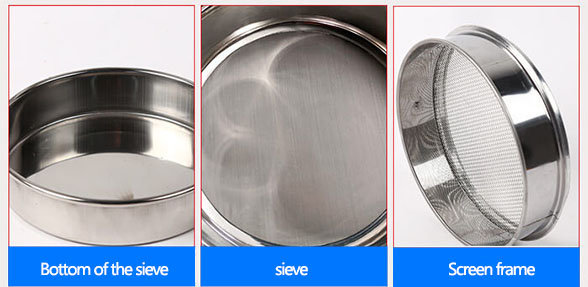
Screen bottom: stainless steel wire mesh, galvanized wire mesh, nylon wire mesh, chrome-plated sheet, stainless steel sheet, galvanized sheet, copper sheet, wood board, aluminum alloy sheet, plastic sheet, etc.
Screen frame: stainless steel plate, mild steel plate, wooden frame
Screen bottom shape: square hole, round hole, diamond hole
Features: wear-resistant, easy to use, suitable for grading screening
Screen frame: double-layer chrome-plated punch frame
Bottom mesh: 304 stainless steel mesh (0.074mm--1.0mm)
New standard Soil Test Sieve: diameter 300mm mesh range 0.074mm-60mm
10 sieves plus a set of bottom cover, respectively: 0.074mm, 0.25mm, 0.5mm, 1mm, 2mm, 5mm, 10mm, 20mm, 40mm, 60mm.
Or galvanized punching plate (above 2.0mm)
1. Coarse sieves commonly used in geotechnical tests are generally round holes with apertures of 100, 80, 60, 40, 20, 10, 5, 2mm; fine sieves are generally square holes with equivalent apertures of 2.0, 1.0, 0.5, 0.25 , 0.10, 0.075mm. There are some differences in the pore size classification of analytical sieves used in different countries and departments;
2. Analytical balance, analytical balance needs two types according to the weighing range and accuracy: (1) weighing 10kg, with a sense of 1g, (2) weighing 1000g, with a sense of 0.1g;
3. Shaker, the specification stipulates that the shaker can shake in the horizontal direction and slap in the vertical direction. The number of shaking is 100~200 times/min, and the number of slaps is 50~70 times/min;
1. From the air-dried loose soil samples, the soil was taken by quartering.
2. Pass the sample through a 2mm sieve, and weigh the soil mass above and below the sieve, respectively. Take the soil above the 2mm sieve and pour it into the upper sieve of the stacked coarse sieve, and pour the soil under the 2mm sieve into the upper sieve of the fine sieve stacked in sequence (the analysis sieves are stacked from top to bottom, from large to small) . Use a sieve shaker to fully sieve and analyze until the diameter of the soil particles on each sieve is larger than the sieve aperture, generally shake the sieve for 15~30min;
3. Starting from the large aperture sieve, remove each sieve in sequence, and weigh the soil left on each sieve separately, accurate to 0.1g. The difference between the sum of the soil mass on each sieve and the total soil mass shall not be greater than 1% of the total soil mass;
4. Calculate the particle group content and cumulative content, draw the gradation curve, obtain each characteristic particle size, analyze the gradation of the soil, and name it according to the specification
| Soil particle size (mm) | <2mm | <10mm | <20mm | <40mm | >40mm |
| Sampling mass (g) | 100-300g | 300-900g | 1000-2000g | 2000-4000g | Above 4000g |
| Soil Project | standard | Soil Sieve Requirements | Calibration result |
| moisture | Determination of soil dry matter and moisture Gravimetric method HJ 613-2011 |
Aperture 2mm | 2.07mm |
| organic carbon | Determination of soil organic carbon Potassium Dichromate Oxidation-Spectrophotometry HJ 615-2011 |
Aperture 2mm | 1.93mm |
| Aperture 2mm | 0.262mm | ||
| total chromium | Determination of total chromium in soil flame atomic absorption spectrophotometry HJ491-2009 |
Aperture 0.149mm | 0.153mm |
| copper | Determination of soil quality copper and zinc flame atomic absorption spectrophotometry GB/T17138-1997 |
Aperture 2mm | 2.07mm |
| Zinc | Aperture 0.149mm | 0.153mm | |
| lead | Determination of lead and cadmium in soil quality graphite furnace atomic absorption spectrophotometry GB/T 17141-1997 Determination of soil quality lead and cadmium KI-MIBK extraction flame atomic absorption spectrophotometry GB/T17141-1997 |
Aperture 2mm | 2.07mm |
| cadmium | Aperture 0.149mm | 0.153mm |
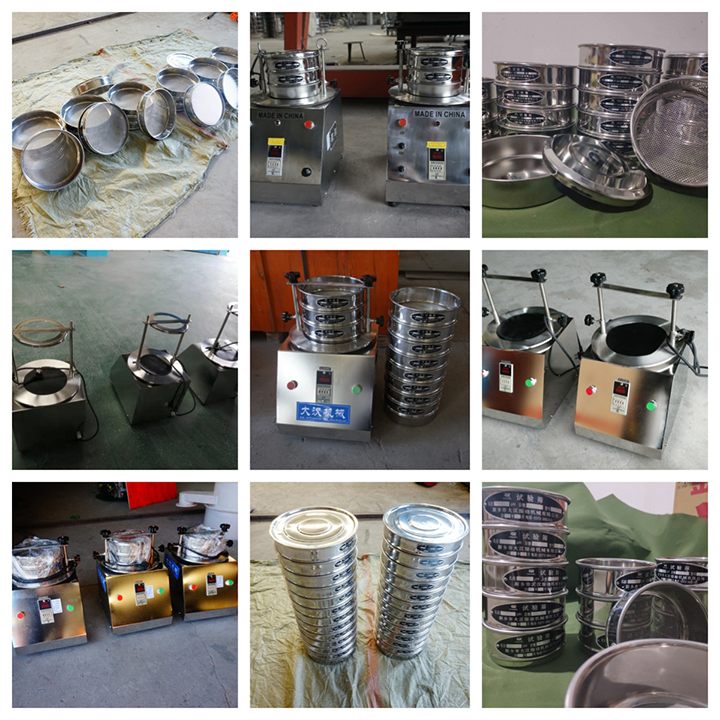
Screening particle size: 0.025-3mm
Price: $650.00 - $800.00/Set
Mesh sizes: 20 microns-5 mm
Price: $656.00 - $975.00/Sets
Screening particle size: 0.025-3mm
Price: $650.00 - $800.00/Set
Test Sieve Shaker is an instrument for detecting and analyzing the particle size structure and particle size distribution of 2kg of material in the test sieve. Test Sieve Shaker Pro...
Pharmacopoeial sieves (standard pharmacopoeial sieves) refers to the sieves used for pharmaceutical production according to the national uniform specifications stipulated in the Pha...
Application of wet sieve test screening material
In many cases, wet sieve test sieving, despite the inconveniences that come with it, has clear advantages over dry sieving. For example, the material to be tested may have been susp...
What is the difference between wet sieving and dry sieving
The sieving test is divided into wet sieving test and dry sieving test, so what is the difference between wet sieving and dry sieving? difference Wet sieving test Dry sieving test i...
Are you interested?
![]()
Then we look forward to hearing from you
Contact Us
Industrials
Yanjin county forest park gate to the west 1000 meters north road sitemap
